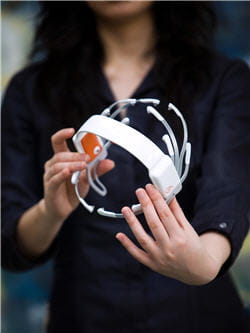Control the computer by thinking
Who has never dreamed to control a computer by thought? Gone are the constraints represented by the mouse and keyboard, the drawbacks goodbye to typos ... Research work there.

The development of this research was born of advances in knowledge of the brain. Past 20 years, it has been possible to record with finesse different brain electrical activity. The principle of "brain-computer interface" (or for BCI Brain Computer Interface) is directly based on this new knowledge. This new discipline aims to develop a device to capture brain electrical activity in the form of data, which are then interpreted by a computer. In response, the machine must perform an action accordingly, giving back to the individual. This loop interactions is the premise of starting work.
Then y can imagine all kinds of medical applications in the entertainment industry: control of a wheelchair, prosthesis, use automation (that is to say, to control all the equipment of a typical home HIFI), in video games, etc..
Smart headphones
Several types of approaches are proposed to develop this technology. The first is called "non-invasive" does not require intracranial implant to function. The method is based on brain imaging techniques, in particular the electroencephalogram (EEG). When a brain area is activated, it generates an electric current to the scalp. This is detectable by a headset with microelectrodes. The difficulty in the field is that the brain never stops working. Must be able to transmit the waves that are relevant to the project in question.
The Emotiv headset EPOCtm new generation, perhaps the future of video game controllers. According to the manufacturer, it would be able to detect, through the analysis of EEG and facial expression, thirty different expressions such as tension or excitement. The game would then be able to react according to our thoughts? © Emotiv Systems
In 2006, a team of Wadsworth in New York has demonstrated that writing a text only thought was possible. For this it was necessary that the subject, with his helmet, focuses its attention on the letter that he wanted to kick a rectangle containing the alphabet. When it was highlighted, the peak of activity generated allowed the computer to transcribe the information. Typing speed was not comparable with the hands, as needed about 15 seconds to type a letter. The pause time of the helmet was also not significant, since it took about an hour for all the electrodes are in place. These results suggest nonetheless predict that the technique can work and be improved. Specific waves, such as p300, issued in situations of surprise, 300 milliseconds after an external stimulus, are also studied in experiments of the same type.
Other applications were also tested: those, for example, called "the mental image of the movement." To do this, the subject must undergo before a workout with the computer so that it recognizes the right brain peaks: he must imagine themselves to move forward, backward, right and left. This changes the amplitude of its brainwaves, which are then stored by the computer. Once the learning phase is completed, the experiment is to put the subject in a virtual environment, where it can move at will, without moving from his chair. This technology is of particular interest to game developers, who see a new videogame experience in virtual worlds like "Second Life".

The second approach is to install an electronic implant surgically directly into the brain, the aim being that the device detects nerve activity in situ and retransmit to the computer. This technique is called "invasive". This system has the advantage of being directly in the source area of interest, the noise from other parts of the brain are minimized. Most of the tests were, for the moment, carried out on animals.
In humans, experience the most promising area was conducted in 2006 in the United States. The researchers introduced a chip a few millimeters in the brain of a quadriplegic at the area responsible for voluntary movements. After a few sessions calibration, the young man was able to control the pointer on the screen and check your messages without moving
. He could perform these actions while conversing, showing that the method was sensitive enough and did not require intense concentration. The device was implanted for a year before being removed due to a malfunction. The downside, however, is the cumbersome process and the risk of long-term infection that could generate.
So what about these new technologies: exciting or terrifying? These avenues of research still great hope for people with physical disabilities. Currently, non-invasive methods are gaining more and more resolution, suggesting they will eventually be preferred. If advances in brain-computer interface followed Moore's Law, saying that the computing power of computers will double every 18 months, we think that the use of mouse and keyboard duo will no longer be necessary in the years to come.